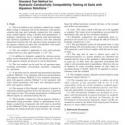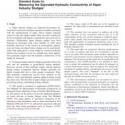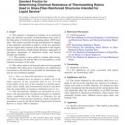No products
ASTM D7100-11(2020)
ASTM D7100-11(2020) Standard Test Method for Hydraulic Conductivity Compatibility Testing of Soils with Aqueous Solutions
standard by ASTM International, 02/15/2020
Full Description
1.1This test method covers hydraulic conductivity compatibility testing of saturated soils in the laboratory with aqueous solutions that may alter hydraulic conductivity (for example, waste related liquids) using a flexible-wall permeameter. A hydraulic conductivity test is conducted until both hydraulic and chemical equilibrium are achieved such that potential interactions between the soil specimen being permeated and the aqueous solution are taken into consideration with respect to the measured hydraulic conductivity.
1.2This test method is applicable to soils with hydraulic conductivities less than approximately 1 10-8 m/s.
1.3In addition to hydraulic conductivity, intrinsic permeability can be determined for a soil if the density and viscosity of the aqueous solution are known or can be determined.
1.4This test method can be used for all specimen types, including undisturbed, reconstituted, remolded, compacted, etc. specimens.
1.5A specimen may be saturated and permeated using three methods. Method 1 is for saturation with water and permeation with aqueous solution. Method 2 is for saturation and permeation with aqueous solution. Method 3 is for saturation with water, initial permeation with water, and subsequent permeation with aqueous solution.
1.6The amount of flow through a specimen in response to a hydraulic gradient generated across the specimen is measured with respect to time. The amount and properties of influent and effluent liquids are monitored during the test.
1.7The hydraulic conductivity with an aqueous solution is determined using procedures similar to determination of hydraulic conductivity of saturated soils with water as described in Test Methods D5084. Several test procedures can be used, including the falling headwater-rising tailwater, the constant-head, the falling headwater-constant tailwater, or the constant rate-of-flow test procedures.
1.8Units-The values stated in SI units are to be regarded as standard. The values given in parentheses are provided for information only and are not considered standard.
1.8.1Hydraulic conductivity has traditionally been expressed in cm/s in the U.S., even though the official SI unit for hydraulic conductivity is m/s.
1.8.2The gravitational system of inch-pound units is used when dealing with inch-pound units. In this system, the pound (lbf) represents a unit of force (weight), while the unit for mass is slugs.
1.8.3The slug unit of mass is almost never used in commercial practice; i.e., density, balances, etc. Therefore, the standard unit for mass in this standard is either kilogram (kg) or gram (g), or both. Also, the equivalent inch-pound unit (slug) is not given/presented in parentheses. However, the use of balances or scales recording pounds of mass (lbm) or recording density in lbm/ft shall not be regarded as nonconformance with this standard.
1.9This standard contains a Hazards section related to using hazardous liquids (Section 7).
1.10This standard does not purport to address all of the safety concerns, if any, associated with its use. It is the responsibility of the user of this standard to establish appropriate safety, health, and environmental practices and determine the applicability of regulatory limitations prior to use.
1.11This international standard was developed in accordance with internationally recognized principles on standardization established in the Decision on Principles for the Development of International Standards, Guides and Recommendations issued by the World Trade Organization Technical Barriers to Trade (TBT) Committee.


































